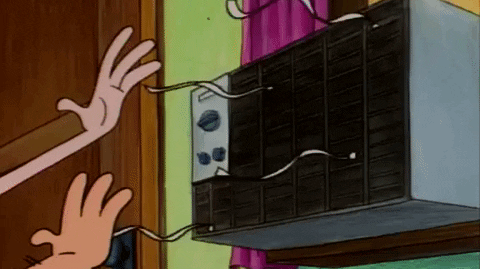This Innovative Strategy Could Remove Electricity From Air Conditioning
Researchers say a new type of film could revolutionize staying cool. Hey Arnold/Giphy
Hey Arnold/Giphy
News that is entertaining to read
Subscribe for free to get more stories like this directly to your inboxIt’s a vicious circle in our modern society: The Earth is getting warmer, so we crank up the AC, which makes global warming worse, so we turn up the air even more, and so on and so on.
But what if we could cool our homes and vehicles without using electricity? It sounds too good to be true, but scientists think they know how it might be possible.
The rise of PDRC
Without getting too technical, the crux of this possible solution involves materials that possess a property known as passive daytime radiative cooling, or PDRC for short. Basically, this is a process by which an insulated surface radiates heat that essentially evaporates to maintain a lower temperature than the atmosphere around it.
If PDRC can be used on a large scale in buildings and automobiles, it could massively cut down on greenhouse gas emissions and other forms of pollution created by traditional air conditioning units.
Is it a realistic solution?
So far, there’s no working model that proves the feasibility of this strategy. Nevertheless, a team of Cambridge University researchers is currently in the process of creating a prototype.
They’re producing a dual-layered cellulose film out of plant-based materials that they say remains cool even when hit with the sun’s hot rays.
While injecting this film with a pigment can destroy its PDRC properties, researchers say they’re also investigating a way to use natural prisms to allow the film to reflect certain colors. If successful, these materials could be used in a variety of settings without negatively impacting the aesthetics of their surroundings.
Of course, the biggest priority is efficacy — and studies show the cellulose nanocrystals used to create the film are able to remain roughly 7 degrees Fahrenheit lower than the surrounding atmosphere even in direct sunlight.
 Why Is The Aging Voyager 1 Probe Sending Back Incoherent Communications?
It's been speaking gibberish for a few months and officials are concerned.
Why Is The Aging Voyager 1 Probe Sending Back Incoherent Communications?
It's been speaking gibberish for a few months and officials are concerned. One Woman’s Massive Donation Is Wiping Out Tuition At This Medical School
Her inheritance came with the instruction to do "whatever you think is right."
One Woman’s Massive Donation Is Wiping Out Tuition At This Medical School
Her inheritance came with the instruction to do "whatever you think is right." Woman’s Pets Will Inherit Her Multimillion-Dollar Fortune, Not Her Kids
It's not the first time four-legged heirs were named in a will.
Woman’s Pets Will Inherit Her Multimillion-Dollar Fortune, Not Her Kids
It's not the first time four-legged heirs were named in a will.